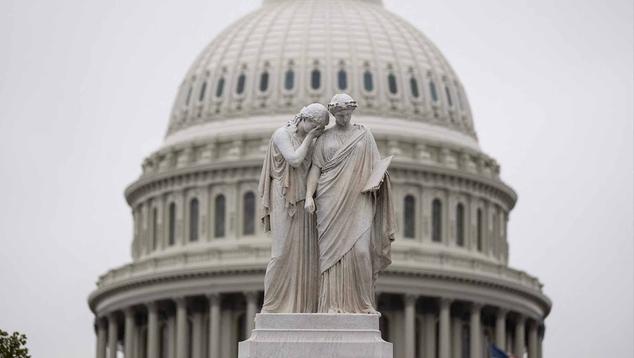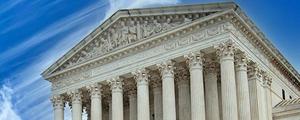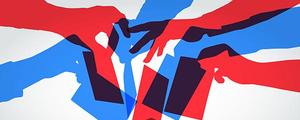Story Highlights
- Republican and Democratic Parties viewed unfavorably on balance
- Between the two, Republican Party trusted more on economy and security
- GOP also ahead on which party can handle “most important problem”
WASHINGTON, D.C. -- The two major political parties remain unpopular in the U.S., with 56% of Americans viewing the Republican Party unfavorably and 58% saying the same of the Democratic Party.
Although both parties are about equally disliked, the public chooses the Republican Party over the Democratic Party by healthy margins when asked which will better safeguard the nation’s prosperity and security.
- Fifty-three percent of Americans believe the Republican Party will do a better job of keeping the country prosperous over the next few years, whereas 39% choose the Democratic Party.
- A slightly larger majority, 57%, have greater faith in the Republican Party to protect the country from international terrorism and military threats, while 35% favor the Democrats.
The latest results are from a Sept. 1-23 Gallup poll in which more than eight in 10 Americans disapprove of the job the politically divided Congress is doing, close to six in 10 disapprove of President Joe Biden’s job performance, and nearly three-quarters feel pessimistic about the direction of the economy.
Historically Ample Leads for Republicans
Republicans’ 14-percentage-point lead in public preferences for keeping the country prosperous is up from a 10-point margin last year and is its widest advantage on this measure since mid-1991. That followed a period from the mid- to late 1980s when Republicans performed unusually well on this measure, historically. However, in the past three decades, the parties have been more closely matched in perceptions of which can better maintain the nation’s economic health or the Democratic Party has led by a solid margin.
The GOP’s current standing with Americans is even stronger on matters of national security, where it leads the Democratic Party by 22 points for protecting the country from international terrorism and military threats.
The Republican Party has led on this measure in all but two readings in the trend originating in 2002, but today’s margin is one of the widest in that more limited stretch of time.
GOP Holds Edge for Handling Americans’ Top Worry
The recent poll also finds the Republican Party leading the Democrats as the party more Americans choose as better able to handle whatever problem they name as the most important facing the country. Forty-four percent say the Republican Party is better, while 36% name the Democratic Party and the rest say the parties are the same or have no preference. This is at a time when the economy, government/poor leadership and immigration lead Americans’ open-ended responses when asked to name the most important problem facing the country.
Although Republicans periodically enjoyed strong leads on this party preference measure between the 1940s and 1980s, today’s eight-point advantage for the Republicans is fairly uncommon in the context of the trend since 1992. In addition to its 11-point advantage last year, those exceptions include a seven-point lead for the GOP in 2011 and a slight edge in 2015 and 2016.
Neither Party Has Leg Up on Overall Image
Republicans have not been able to convert their advantages on these issues to a positive image of the party overall, or even to an advantage over the Democratic Party in favorability. Currently, 56% of Americans view the Republican Party unfavorably, while 42% view it favorably. This is consistent with the Republican Party’s negative image in most measures taken since 2005, when the party’s favorable rating suffered under then-President George W. Bush’s waning job approval rating and the growing unpopularity of the Iraq War.
The Republicans’ image was mostly positive for a 13-year stretch prior to that. The primary exceptions were recorded in late 1998 and early 1999 when they impeached then-President Bill Clinton and he was acquitted in the Senate trial on those charges.
The Democratic Party’s image roughly matches the Republicans’ today, with 58% of Americans having an unfavorable view of it and 40% a favorable view.
Like the Republican Party, the Democratic Party’s image was mostly positive in the 1990s and early 2000s, but its favorability extended longer, up to 2009. Since then, its image has been net-negative or, at best, neutral in all readings except one, in November 2012, after Barack Obama was reelected for his second term as president.
Independents Account for Parties’ Negative Images, Republicans’ Strengths
Republican and Democratic partisans mostly view their own party favorably; however, they tend to be alone in that sentiment, as the majority of independents, as well as most members of the opposing party, view it unfavorably.
At the same time, independents mostly account for Republicans’ advantages over Democrats in national preferences for which party can better manage the nation’s economy and military security. Barely a third of independents prefer the Democratic Party on these measures, while more than half choose the Republican Party. However, further boosting the Republicans' advantages, slightly more Democrats than Republicans say the opposing party is better for handling both issues, particularly for maintaining the nation’s security from military threats and terrorism.
Bottom Line
The nation has been in a protracted period since 2010 where Americans have generally viewed both major parties unfavorably. Yet, with the parties dominating U.S. politics at every level, which party Americans put greater trust in to handle the most basic responsibilities of government -- ensuring economic security and safety from military threats -- could influence how Americans vote in elections.
Americans currently see Republicans as the party better equipped to manage these challenges, which could enhance Republicans’ position in promoting their agenda in Washington in the near term. However, Gallup’s trends show that party advantages often change in the span of a year, thus making these indicators of limited value in forecasting what the public’s mood will be at the time of the next presidential election.
To stay up to date with the latest Gallup News insights and updates, follow us on Twitter.
Learn more about how the Gallup Poll Social Series works.
View complete question responses and trends (PDF download).




